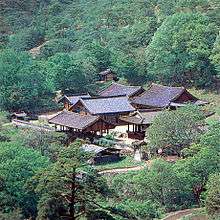Bongjeongsa
| UNESCO World Heritage site | |
|---|---|
 | |
| Location | Andong, Republic of Korea |
| Criteria | Cultural: iii |
| Reference | 1562-3 |
| Inscription | 2018 (42nd Session) |
| Coordinates | 36°39′12″N 128°39′45.2″E / 36.65333°N 128.662556°E |
 Location of Bongjeongsa in South Korea | |
| Bongjeongsa | |
|
Geungnakjeon - The oldest wooden building in Korea with the 3-storied pagoda in front at Bongjeongsa. | |
| Korean name | |
|---|---|
| Hangul | 봉정사 |
| Hanja | 鳳停寺 |
| Revised Romanization | Bongjeongsa |
| McCune–Reischauer | Pongjŏngsa |
Coordinates: 36°39′12″N 128°39′43″E / 36.653279°N 128.661964°E
| Wikimedia Commons has media related to Bongjeongsa. |
Bongjeongsa is a Korean Buddhist temple on the slopes of Mount Cheondeung in Andong city, North Gyeongsang Province, South Korea. It is a subsidiary temple of Gounsa, the head temple of the 16th branch of Jogye Order.[1]
At 1,650 m²/17,760 ft², Bongjeongsa is the largest temple in Andong, and is the site of the oldest wooden building, Geuknakjeon, in Korea.[2] There are 10 buildings at the main temple and a total of 9 other buildings at Bongjeongsa's two sub temples found to the east and west of the main temple complex.
This temple constitutes the oldest example of wooden architecture in Korea. During her trip to Korea in 1999, Queen Elizabeth II of the United Kingdom was particularly impressed by the scale and beauty of Bongjeonsa Temple. [3]
Origin
Bongjeongsa is believed first established by Monk Uisang in 672 during the 12th year of King Munmu of Silla (661-681), however, an inscription found during a restoration of Geuknakjeon state that Neungin Daedeuk, a disciple of Monk Uisang, established the temple.[2][4]
In 1363 the last major reconstruction took place and in 1625 and 1972, renovations were undertaken.[4]
Treasures
National Treasure #15
Built in the mid-Goryeo Period, around 12th and 13th century,[5] Geukrakjeon (Nirvana Hall), from the Goryeo Dynasty era, is the oldest wooden building in Korea.[2] Geukrakjeon was constructed with slated windows and no door.[6] Most old temple buildings were destroyed over the years by natural disasters or acts of war. Although restored from time to time, Geukrakjeon remains an original construction.
National Treasure #311
Daeungjeon is the main temple hall, with stunning original murals,[6] representing building styles of the early Joseon Dynasty era. Notable for the style of pillars, most likely brought from Song dynasty, Daeungjeon incorporates a column-head and curved bracket form.[4]
Treasure #448
Hwaeom Gangdang, a study hall, constructed in 1588 during the mid-Joseon Dynasty.[6]
Treasure #449
Gogeumdang, a small worship hall, constructed in 1616.[6]
Gyeongsangbuk-do Cultural Heritage #325
Manseru is a building that was constructed during the reign of King Sukjong of Joseon, and serves as a gateway to the main hall of the temple. On November 1, 2001, it was designated as Gyeongsangbuk-do tangible national treasure No. 325.[7]
Gyeongsangbuk-do Cultural Heritage #182
The three-story stone pagoda was designated as Kyongsangbuk-do Tangible Cultural Heritage No. 182 on December 29, 1984. It is 318 cm tall, and is believed to have been made during the mid- Goryeo Dynasty.[8]
Gallery
- Bongjeongsa Daeungjeon - National Treasure #311
- Bongjeongsa Maseru
 Drum and wooden fish in the Bongjeongsa Manseru pavilion
Drum and wooden fish in the Bongjeongsa Manseru pavilion- Bongjeongsa Bell Pavilion
See also
References
- ↑ (in Korean) 봉정사 鳳停寺 (Bongjeongs) Archived June 10, 2011, at the Wayback Machine. Nate / Encyclopedia of Korean Culture
- 1 2 3 "Visitkorea". Retrieved 2011-01-29.
- ↑ Yoo, Myeong-jong (2009). Temples of Korea. Myeong-jong. p. 48.
- 1 2 3 "Orientalarchitecture". Retrieved 2011-01-29.
- ↑ , Eng.koreatemple. Retrieved 2012-02-28
- 1 2 3 4 "English.visitkorea". Retrieved 2011-01-30.
- ↑ BongJeongsa-Manseru
- ↑ http://terms.naver.com/entry.nhn?docId=1195987&cid=40942&categoryId=33613 Bongjeongsa-Three-story stone pagoda
External links
| Wikimedia Commons has media related to Bongjeongsa. |